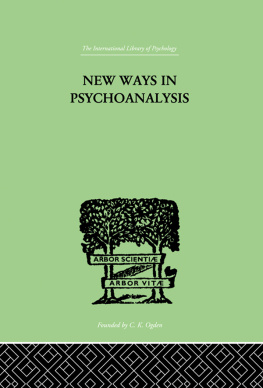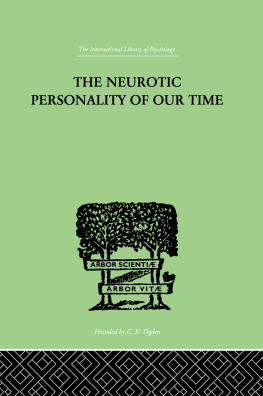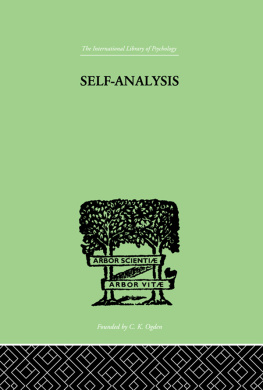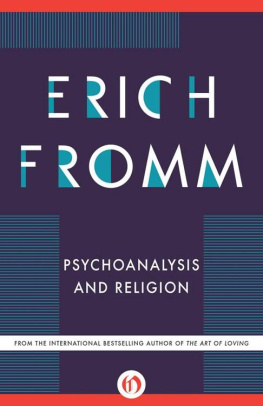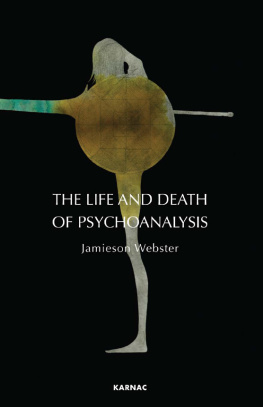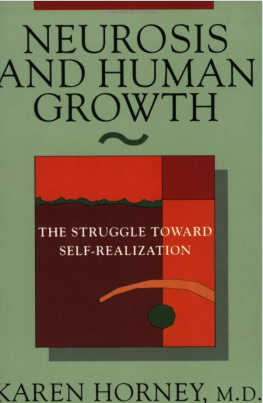The International Library of Psychology
NEW WAYS IN PSYCHOANALYSIS

Founded by C. K. Ogden
The International Library of Psychology
PSYCHOANALYSIS
In 28 Volumes
I | The Elements of Practical Psycho-Analysis | Bousfield |
II | A Neglected Complex and its Relation to Freudian Psychology | Bousfield |
III | The Omnipotent Self | Bousfield |
IV | The Social Basis of Consciousness | Burrow |
V | What is Psychoanalysis? | Coriat |
VI | The Psychoanalytic Theory of Neurosis | Fenichel |
VII | The Technique of Psycho-Analysis | Forsyth |
VIII | Leonardo da Vinci | Freud |
IX | Totem and Taboo | Freud |
X | Wit and its Relation to the Unconscious | Freud |
XI | Morbid Fears and Compulsions | Frink |
XII | Facts and Theories of Psychoanalysis | Hendrick |
XIII | Fathers or Sons? | Hopkins |
XIV | Neurosis and Human Growth | Horney |
XV | The Neurotic Personality of Our Time | Horney |
XVI | New Ways in Psychoanalysis | Horney |
XVII | Our Inner Conflicts | Horney |
XVIII | Self-Analysis | Horney |
XIX | Childhood and After | Isaacs |
XX | Social Development in Young Children | Isaacs |
XXI | Problems in Psychopathology | Mitchell |
XXII | The Psychoanalytic Method | Pfister |
XXIII | The Trauma of Birth | Rank |
XXIV | On the Bringing Up of Children | Rickman |
XXV | Conflict and Dream | Rivers |
XXVI | Psychoanalysis and Suggestion Therapy | Stekel |
XXVII | Psychoanalysis and Behaviour | Tridon |
XXVIII | Character and the Unconscious | van der Hoop |
NEW WAYS IN PSYCHOANALYSIS
KAREN HORNEY

First published in 1939 by
Routledge
Reprinted in 1999 by
Routledge
2 Park Square, Milton Park, Abingdon, Oxon, OX14 4RN
Transferred to Digital Printing 2007
1939 Karen Horney
All rights reserved. No part of this book may be reprinted or reproduced or utilized in any form or by any electronic, mechanical, or other means, now known or hereafter invented, including photocopying and recording, or in any information storage or retrieval system, without permission in writing from the publishers.
The publishers have made every effort to contact authors/copyright holders of the works reprinted in the International Library of Psychology.
This has not been possible in every case, however, and we would welcome correspondence from those individuals/companies we have been unable to trace.
These reprints are taken from original copies of each book. In many cases the condition of these originals is not perfect. The publisher has gone to great lengths to ensure the quality of these reprints, but wishes to point out that certain characteristics of the original copies will, of necessity, be apparent in reprints thereof.
British Library Cataloguing in Publication Data
A CIP catalogue record for this book is available from the British Library
New Ways in Psychoanalysis
ISBN 0415-21097-6
Psychoanalysis: 28 Volumes
ISBN 0415-21132-8
The International Library of Psychology: 204 Volumes
ISBN 0415-19132-7
CONTENTS
MY desire to make a critical re-evaluation of psychoanalytical theories had its origin in a dissatisfaction with therapeutic results. I found that almost every patient offered problems for which our accepted psychoanalytical knowledge offered no means of solution, and which therefore remained unsolved.
As most analysts probably do, at first I attributed the resulting uncertainty to my own lack of experience, lack of understanding or blind spots. I remember pestering more experienced colleagues with questions such as what Freud or they understood by ego, why sadistic impulses were interrelated with anal libido, and why so many different trends were regarded as an expression of latent homosexualitywithout, however, obtaining answers that seemed satisfactory.
I had my first active doubts as to the validity of psychoanalytical theories when I read Freuds concept of feminine psychology, doubts which were then strengthened by his postulate of the death instinct. But it was several years before I started to think through psychoanalytical theories in a critical way.
As will be seen throughout the book, the system of theories which Freud has gradually developed is so consistent that when one is once entrenched in them it is difficult to make observations unbiased by his way of thinking. It is only through recognizing the debatable premises on which this system is built that one acquires a clearer vision as to the sources of error contained in the individual theories. In all sincerity I may say that I regard myself qualified to make the criticisms contained in this book, because I consistently applied Freuds theories for a period of over fifteen years.
The resistance which many psychiatrists as well as laymen feel toward orthodox psychoanalysis is due not only to emotional sources, as is assumed, but also to the debatable character of many theories. The complete refutation of psychoanalysis which these critics often resort to is regrettable because it leads to discarding the valid with the dubitable and thereby prevents a recognition of what psychoanalysis essentially has to offer. I found that the more I took a critical stand toward a series of psychoanalytical theories, the more I realized the constructive value of Freuds fundamental findings and the more paths opened up for the understanding of psychological problems.
Thus the purpose of this book is not to show what is wrong with psychoanalysis, but, through eliminating the debatable elements, to enable psychoanalysis to develop to the height of its potentialities. As a result of both theoretical considerations and practical experience, I believe that the range of problems which can be understood is enlarged considerably if we cut loose from certain historically determined theoretical premises and discard the theories arising on that basis.
Next page
